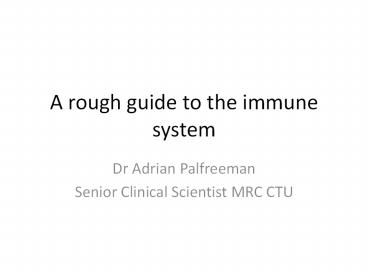A rough guide to the immune system - PowerPoint PPT Presentation
Title:
A rough guide to the immune system
Description:
... (i.e. Helminthic parasites) . Abundant at sites of allergic reactions. Components of the immune system Monocyte The largest nucleated cell of the blood ... – PowerPoint PPT presentation
Number of Views:61
Avg rating:3.0/5.0
Title: A rough guide to the immune system
1
A rough guide to the immune system
- Dr Adrian Palfreeman
- Senior Clinical Scientist MRC CTU
2
Stem cells
- Stem cells why they matter
3
Neutrophil (polymorph)
- Multi-lobed nucleus.
- Commonest leucocyte (2500-7500/mm3 of blood).
- A short-lived phagocytic cell whose granules
contain numerous bactericidal substances. - leave the blood to go to tissues where infection
or inflammation is developing
4
Eosinophil
- A leucocyte whose large refractile granules
contain a number of highly basic or cationic
proteins, - possibly important in killing larger parasites
including worms. - Bind avidly to IgE-coated particles (i.e.
Helminthic parasites) . - Abundant at sites of allergic reactions.
5
Components of the immune system
6
- Monocyte
- The largest nucleated cell of the blood (16-20µm
- diameter), developing into a macrophage when it
- migrates into the tissues.
- Macrophage (A professional antigen presenting
cell) - The principal resident phagocyte of the tissues.
- Strongly phagocytic of particles and microbes.
- Has receptors for Ig and complement.
- CNS microglia
- Liver Kupffer cells
- Lungs alveolar macrophages
- Bone osteoclasts
7
(No Transcript)
8
T lymphocyte (T cell)
- A thymus-derived (or processed) lymphocyte.
- 1500 - 4000/mm3 blood
- 6-15µm diameter (red blood cell 7.2µm diam.)
- 2 main subdivisions
- CD8 (cytotoxic T cells)
- - CD4 (helper T cells)
9
(No Transcript)
10
(No Transcript)
11
- B lymphocyte
- A bone marrow- (or in birds, bursa-) derived
lymphocyte, the precursor of antibody-forming
cells. In foetal life, the liver may play the
role of bursa. - NK (Natural Killer) cells
- do not have to recognise a specific antigen
before acting against it - are effective against a wide range of infectious
microbes.
12
The 2 arms of the adaptiveimmune response
- 1. Humoral immunity (antibodies)
- 2. Cellular immunity (T-cells)
- Sub-divided into T helper cells (CD4) and
- Cytotoxic T cells (CD8)
13
CD4 Lymphocytes (T helper cells)
- coordinate much of the immune response to
micro-organisms - help B-cells respond to foreign proteins
- secrete substances that enable CD8 T-cells to
proliferate - activate macrophages so that they can kill
certain organisms, including some organisms
associated HIV infection.
14
CD8 Lymphocytes (Cytotoxic T cells)
- kill cells in the body identified as abnormal or
foreign - tumour cells
- cells that have been infected by viruses.
15
How does HIV reduce CD4 Cells?
- Increased turnover of cells in response to
infection - Trapping of HIV in lymph nodes
- Shortened survival of CD4 cells
- Reduced production of new cells
- Reduction of T cell progenitor production from
bone marrow
16
Sites of theprincipallymphoid tissueswithin
the humanbody.Primary lymphoidorgansSec
ondary lymphoidorgans
17
Human lymphoid organsPrimary lymphoidorgansSe
condary lymphoidorgans
18
- Lymphoid tissues
- Immune system compartmentalised into
organs/tissues. - Funtionally unified via blood and lymph systems.
- Lymphocytes recirculate.
- In total, equivalent in weight to brain or liver.
- Primary lymphoid organs
- Bone marrow where T and B lymphocytes are made.
- Thymus where T lymphocytes mature/are selected.
- Secondary lymphoid organs
- e.g. spleen, lymph nodes and Peyers patches.
- Contain T cells, B cells, antigen presenting
cells (APCs)
19
T cell precursors(thymocytes) migratefrom the
bone marrowto the thymus to mature.
- Mature T cells leave the
- thymus and migrate to
- secondary lymphoid tissues
- where they may encounter
- foreign antigen.
20
Thymus
- Lobules show - a lymphocyte-dense outer cortex
- - an inner lighter-staining medulla.
- Stromal framework with specialised epithelial
cells, DCs - and macrophages (APCs).
- T cell precursors arrive from the bone marrow.
- Cortex and medulla educate thymocytes into
mature, - competent T cells (1 to 3 of T cells survive
education). - Mature T cells are released into the peripheral
- circulation.
21
THYMUSDevelopingthymocytesoccupy
theinterstices ofan extensivenetwork
ofepithelial cells
22
Clusters of Differentiation (CD)
- CD3 T cells
- CD4 Helper T cells
- CD8 Cytotoxic T cells
- CD16 Macrophages
- CD19 B cells
23
Maturation of T lymphocytes in the thymus
24
Circulatinglymphocytesmeetlymph-bornepathogens
in draininglymph nodes.
25
Lymph node
26
(No Transcript)
27
Cytokines
- Il2 stimulates division of B and T cells and
killing of HIV infected cells by NK cells - IL2 levels reduced in HIV infection
28
IL2
- Does administration of IL2 help?
- Raises CD4 numbers
- Significant side effects
- Injectable
- Short term benefit in clinical trials
- Does it reduce mortality and morbidity in the
long term?
29
Summary
- B cells recognise antigens (antigenic epitopes)
via their monomeric IgM receptor - T cells recognise antigens (small peptides)via
the T cell receptor (TCR) which is always
associated at the cell surface with CD3 11 - The monomeric B cell receptor (and, in fact,
all antibodies) recognise antigens in solution
in their native (folded) state - The TCR does not recognise soluble antigens but
only small antigenic peptides associated with the
Major Histocompatibility (MHC) molecules I II - For a T cell or B cell to be activated 2
appropriate signals are always required - T cells need binding of the TCR to peptide/MHC
plus specific cytokines from the APC (notably IL-
1 and IL-2) and interaction between B7 and CD28 - B cells need binding of mIgM surface receptor
plus signals from TH cells (notably IL-4 and IL-
10) and interaction of CD40/CD40L. - This process has evolved to prevent unwanted
activation of immune cells which can lead to
harmful responses such as allergies and
autoimmunity































